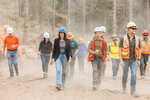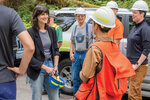

Clear cutting versus thinning, wildfire management, spotted owls, carbon sequestration.
Forestry in Washington is and always has been a slew of complicated and often controversial topics. Take the U.S. Forest Service’s booklet, “a citizens’ guide to national forest planning.” It’s 76 pages long.
On Thursday, Aug. 10, U.S. Rep. Marie Gluesenkamp Perez, D-Washougal, and a commissioner from Lewis County, Scott Brummer, R-Winlock, toured the Huff Timber Sale a few miles south of Randle, hearing about the minutiae of silviculture and species restoration.
The purpose of the tour, though, was grander.
Since 2001, Congress-authorized legislation known as the “Good Neighbor Authority” has allowed the Forest Service to team with states, counties, tribes and other federal agencies for land management.
Without Congressional support of the Farm Bill, the program will cease to exist. Gluesenkamp Perez’s spots on the House of Representatives Committee on Agriculture and its Subcommittee on Forestry make her a key asset for local stakeholders of the forest.
At the Huff site, 300 acres of forest are being thinned on a Department of Natural Resources contract. The project will generate about $2,600,000, all of which will be reinvested into restoration and commercial projects in the Gifford Pinchot. It might even mean repaving the pothole-ridden road to Windy Ridge at Mount St. Helens..
Other sales that aren’t under the Good Neighbor Authority will see funds going beyond the forest.
Decades ago, the land would have been clear cut and the revenue would have stayed mostly outside the forest, funding Washingtonian schools, counties and more.
After the sale, the forest would have been over-planted with Douglas fir, harming the forest’s biodiversity and its ability for succession into healthy habitat.
In the Gifford Pinchot National Forest now, land is sectioned off into chunks of acreage to try to balance the negative side effects of over logging (such as species extinction), and not logging (such as too much fuel for wildfires).
“Fires don’t respect maps,” said Gluesenkamp Perez after the tour. “You need landscape-scale treatment, and if you’re only able to engage the state or the federal land … and not county or tribal engagement, you’re not fixing the problem. You’re not reducing the fuel load effectively.”
Another benefit to the Good Neighbor Authority, Gluesenkamp Perez said, is that tribes and counties, not just the Forest Service, can also reinvest sale revenue.
“It’s a catalyst of investment in the woods. An investment in our rural economies,” she said. “It’s not like a one and done.”
Brummer, the commissioner and a former biologist with the Washington Department of Fish and Wildlife, had more concern than excitement to take away from the site tour.
“I understand the importance of basically coming up with better ways to manage our timber resources, I’m all for that. My concern is that those Forest Service lands and that timber belong to the people,” Brummer said after the tour. “When we’re not harvesting them to … replenish, to be replanted and regrow the next generation of the forest, we also lose out on revenue. Most of that revenue is earmarked for schools.”
Brummer’s worry for the site, he said, wasn’t that the Good Neighbor Authority allowed significant reinvestment in the forest, calling it a generally good program (and noting the state of Forest Service Roads). His concern came down to the forest management plan itself.
A 2011 article from The Chronicle, The Reflector’s sister paper in Centralia, entitled “Despite Fewer Lawsuits, Logging’s in a Pinch” states that in 1990, the Gifford Pinchot National Forest sold more timber — 689 million board feet — than it had in the two decades before the story was published.
Gifford Pinchot Natural Resource Officer Josh Chapman on Thursday said the last five years have averaged sales of 44 million board feet.
Though, the first part of that headline is also true. The Cascade Forest Conservancy, formerly the Gifford Pinchot Task Force, has often been an adversary to the Forest Service. The group won a lawsuit against the federal agency in 2021 regarding vacating drilling permits in the Green River Valley and sued in early 2022 over a road across a pumice plain. Despite that, according to Executive Director Molly Whitney, the environmental advocacy group hasn’t sued the Forest Service over a timber sale in more than a decade.
In that, a forest collaborative known as the Pinchot Partners has been key. The group hosts often starkly different stakeholders who work to create plans for agreement in forest management.
Members include and/or have included representatives from the Cascade Forest Conservancy, the Forest Service, Cowlitz and Yakima tribes, and businesses including Hampton Lumber. Others are Randle-area citizens or former loggers, moved to involvement by their love of the woods.
The Pinchot Partners allow some lawsuit prevention by gathering stakeholders’ diverse perspectives before action is taken in the forest’s management. The group, including three founding members, were also present on the timber sale tour on Thursday.
Brummer said he’ll be interested to watch data from monitoring of the Huff site in the years following the sale. He worries the thinning will lead to all the large trees being toppled by heavy winds.
But significant data on species restoration, he said, would make it easier to get behind these projects.
“We need to follow the science and make sure we’re making sound decisions. Overall, I think this collaboration is worthwhile. I appreciate the Pinchot Partners and what they’ve been doing to hopefully get this to fruition,” Brummer said. “I’m in support of that — that’s why I want them to monitor what comes out of it, so that we don’t just commit ourselves.”